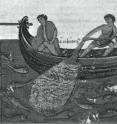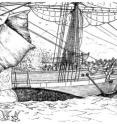Ocean life in olden days: Researchers upend modern notions of 'natural' animal sizes, abundance
Related images
(click to enlarge)
Before oil hunters in the early 1800s harpooned whales by the score, the ocean around New Zealand teemed with about 27,000 southern right whales - roughly 30 times as many as today - according to one of several astonishing reconstructions of ocean life in olden days to be presented at a Census of Marine Life conference May 26-28.
At about the same time, UK researchers say large pods of blue whales and orcas, blue sharks and thresher sharks darkened the waters off Cornwall, England, herds of harbour porpoise pursued fish upriver, and dolphins regularly played in waters inshore.
Using such diverse sources as old ship logs, literary texts, tax accounts, newly translated legal documents and even mounted trophies, Census researchers are piecing together images - some flickering, others in high definition - of fish of such sizes, abundance and distribution in ages past that they stagger modern imaginations.
They are also documenting the timelines over which those giant marine life populations declined.
For example, Census scientists say the size of freshwater fish caught by Europeans started shrinking in medieval times.
Researchers James Barrett and Jen Harland (Cambridge University, UK), Cluny Johnstone (York University, UK) and Mike Richards (Max Planck Institute, Germany) say a shift from eating locally-caught freshwater to marine fish species occurred around 1000 AD.
That's consistent with analyses of scientifically-dated fish remains and historical data from England and northwestern Europe showing smaller freshwater fish and fewer species availability in early medieval times, likely caused by increased exploitation and pollution.
Maria Lucia De Nicolò of the Università di Bologna, meanwhile, has established that new fishing boats and equipment invented in the 1500s made it possible to venture from coastal to deep sea fishing. The real revolution in marine fishing, she says, happened in the mid-1600s when pairs of boats began dragging a net.
Appraising modern marine life through the narrow window of observations during recent decades "skews perceptions," says Andy Rosenberg of the University of New Hampshire, a leader of the Census' History of Marine Animal Population (HMAP) project and chair of the conference.
He says new insights allowed by centuries of information are upending modern notions of "natural" marine life sizes, abundance, habitats and vulnerability, and causing authorities to revisit marine baselines.
In most places human-caused changes to marine ecosystems occurred over millennia while reliable information is often available for just the last few centuries at best. In New Zealand, however, which was first settled by fewer than 300 eastern Pacific islanders around 1280 AD, there is a comparatively short and continuous record of human impacts on the marine environment, including whaling for southern right whales.
This short and well-documented history allows researchers to quantify the full scope of change in at least this one marine ecosystem, from before human presence to the present day, and makes the findings more relevant to policy makers, who plan to use the results as a realistic baseline against which the current and future status of the marine ecosystem can be gauged.
The estimated historic size of New Zealand's southern right whale (Eubalaena australis, www.eol.org/pages/313009) population, for example, is already being incorporated into models of the New Zealand coastal ecosystem to help guide conservation and management.
The Census HMAP team, Jennifer Jackson and Scott Baker (Oregon State University, US), Emma Carroll and Nathalie Patenaude (University of Auckland, New Zealand), and Tim Smith (US National Marine Fisheries Service), estimated the original population through analysis of over 150 whaling logbooks and other records.
And they say with 95% statistical confidence that southern right whales numbered between 22,000 and 32,000 in the early 1800s, declining rapidly once whaling began. By 1925, perhaps as few as 25 reproductive females survived. Today a remnant -- and hopefully recovering - of 1,000 animals is being studied around sub-Antarctic islands south of New Zealand.
Says Alison MacDiarmid, a New Zealand government scientist who organized the work: "These findings point up the need to re-examine the role southern right whales once played both as a grazer of zooplankton and prey, especially during calving close inshore, for killer whales and great white sharks."
Oceans Past II Conference, 2009
International scientists arriving in Vancouver for the second Oceans Past conference (www.hmapcoml.org/oceanspast, May 26-28, hosted by the University of British Columbia), will share such other surprises as these:
- Human fishing and impacts on near-shore and island marine life - including the catching of shellfish, finfish and other marine mammals - apparently began in many parts in the Middle Stone Age - 300,000 to 30,000 years ago - 10 times earlier than previously believed;
- Passages of Latin and Greek verse written in 2nd century CE suggest Romans began trawling with nets;
- In the early to mid 1800s, years of overfishing followed by extreme weather collapsed a European herring fishery. Then, the jellyfish that herring had preyed upon flourished, seriously altering the food web;
- In the mid 1800s, periwinkle snails and rockweed migrated from England to Nova Scotia on the rocks ships carried as ballast - the tip of an "invasion iceberg" of species brought to North America;
- In less than 40 years, Philippine seahorses plunged to just 10% of their original abundance, reckoned in part through fishers' reports of each having caught up to 200 in a night in the early days of that fishery.
A new context for contemporary ocean management
Says Ian Poiner, Chair of the Census Scientific Steering Committee: "Joni Mitchell once famously sang that 'you don't know what you've got 'til it's gone.' But when it comes to marine life, in many cases we're only just starting to fully realize what the planet once had."
"The insights emerging from this research of the past provide a new context for contemporary ocean management. Understanding the magnitude and drivers of change long ago is essential to accurately interpret today's trends and to make future projections."
Dr. Poiner adds that establishing environmental history in mainstream marine science will be one of the Census' enduring legacies.
Scientists involved in the research hail from many disciplines, including palaeontology, archaeology, history, fisheries and ecology.
Using creativity to reveal marine change
Demonstrating one of many novel research techniques, HMAP Caribbean researcher Loren McClenachan of the Scripps Institution of Oceanography, compared photos of 13 groups of "trophy" reef fish landed by Key West-area sport fishermen between 1956 and 2007.
They revealed that average fish size shrank from an estimated 20 kg to 2.3 kg and that the mix of species changed greatly.
From 1956 to 1960, large groupers and other large predatory fish dominated the catches, including sharks that averaged nearly two meters long.
By contrast, small snappers with an average length of 34.4 cm dominated catches in 2007.
A special focus on changing coastal biodiversity
HMAP researchers are also looking closely into the history near Atlantic shores, assessing changes in coastal biodiversity over time.
To illuminate patterns of change by seeing what used to be, project scientists are subjecting rich historical data from five countries to modern sampling and analysis methods, testing the hypothesis that biodiversity has suffered more at sea than on land.
Lessons also from past recoveries
"Most histories of successful marine recoveries are found among mammals and birds, but cases involving marine reptiles and fish also exist. Only in a few cases, however, did they fully recover their former abundance," says researcher Heike Lotze of Canada's Dalhousie University.
Lotze points to hopeful examples of recoveries - sea otters of western North America, elephant seals of Guadalupe, an island off the coast of Baja California, and the Pacific gray whales that roam the American coast, for example - and the causes behind them.
"In the past, some combination of reduced or banned exploitation, pollution controls or habitat protection, especially of breeding colonies and feeding grounds, propelled recovery" she says.
Recovery potential can depend on the magnitude of depletion, the life history of the animals, and the time since collapse. Long-lived marine animals rebound more slowly than short-lived species. Species diversity and food webs have also been identified as important drivers for recovery. And where species have disappeared, their reintroduction by humans can help, says Lotze.
Seeing important patterns over time
"Forecasting and backcasting are two sides of the same coin," says Jesse Ausubel, Program Director of the Census at the Alfred P. Sloan Foundation. "Analytic tools developed by ecologists to predict future abundance have been adapted to reconstruct histories of marine life."
"HMAP's evidence includes a variety of items such as old restaurant menus, whalebone buttons, logbooks and lore, paintings and pavements, isotopes and ice. HMAP researchers keep extending the limits of knowledge by finding new ways to make the past visible. They help us to lift self-imposed blinders on what constitutes useful source material," he adds.
He notes a text written in Sicily in 1153 describing the seas of the North Atlantic as having "animals of such great size that the inhabitants of the islands use their bones and vertebrae in place of wood to build houses. They make hammers, arrows, spears, knives, seats, steps, and in general every sort of thing elsewhere made of wood."
"The History of Marine Animal Populations project gives a head start of decades and even centuries in anticipating trends - both good and bad. Integration of this information will extend databases to help perceive important patterns over larger areas, longer eras and covering more forms of life more reliably."
Concludes Poul Holm, Professor at Trinity College Dublin and global chair of the HMAP project: "While the history of marine animal populations has been one of the great unknowns, recent advances in scientific and historical methodology have enabled HMAP to expand the realm of the known and the knowable."
"We now know that the distribution and abundance of marine animal populations change dramatically over time. Climate and humanity forces changes and while few marine species have gone extinct, entire marine ecosystems may have been depleted beyond recovery. Understanding historical patterns of resource exploitation and identifying what has actually been lost in the habitat is essential to develop and implement recovery plans for depleted marine ecosystems."


